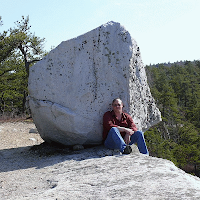Beautiful chatter marks, striations, and glaical polishing in Shawangunk Conglomerate near Lake Minnewaska (Swiss army knife for scale).
These glacial features aren't caused by the ice moving over the rocks - you can take an ice cube and rub it on a rock all day and it's not going to affect it (especially a rock made entirely of the hard mineral quartz as the Shawangunk Conglomerate is). These features are formed from rocks and sediment carried in the ice making it abrasive - just like sandpaper moving 24/7 for thousands of years!
Chatter marks are crescent-shaped chips in the bedrock indicating the direction of glacial movement (away from the camera here). As glaciers move, they pluck up rocks which get embedded in the base of the ice. These rocks then "skip" across the bedrock chipping out the marks. Striations are the fine parallel lines formed by subglacial rocks scratching the bedrock as the glacier moves and glacial polishing is from sediment embedded in the base of the glacier acting like sandpaper.
These kinds of features (and others) were noticed for what they were by the brilliant Swiss geologist/paleontologist Louis Agassiz (1807-1883) who studied glaciers and glacial features in the Alps and then saw these exact same erosional and depositional features throughout Europe and later in North America (he taught at Harvard). Agassiz proposed a great Ice Age as the explanation for these features.
Any keen observer in the Hudson Valley will notice dozens of different lines of evidence indicating that this area was once covered by a great expanse of glacial ice. This outcrop (and thousands of others just like it in the Shawangunks, is just one example). As time goes on, I'll post others.
Tuesday, August 17, 2010
Subscribe to:
Post Comments (Atom)



No comments:
Post a Comment